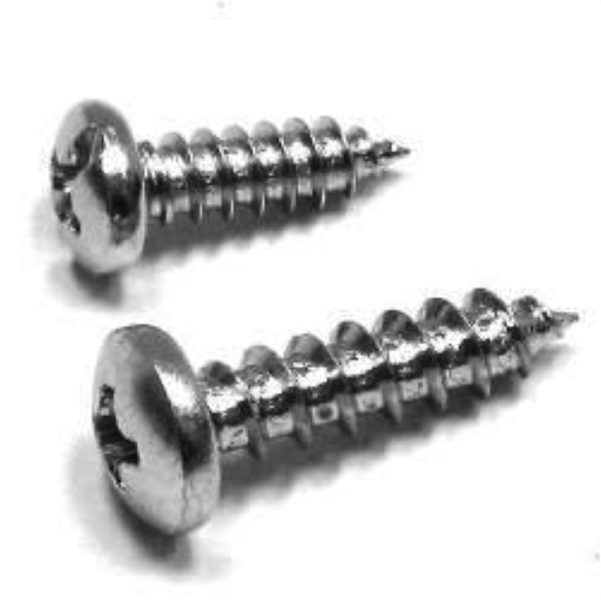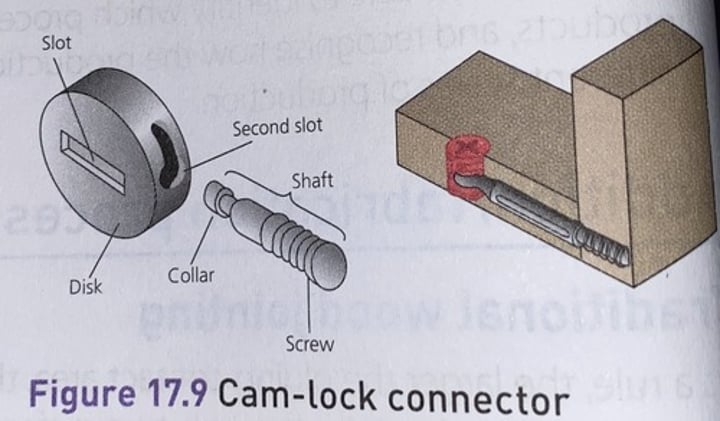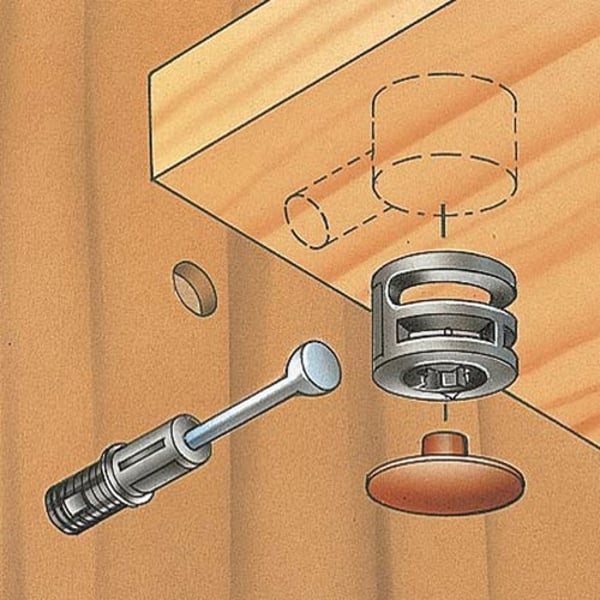[K] HARDWARE AND METAL FITTINGS ✅
1/88
There's no tags or description
Looks like no tags are added yet.
Name | Mastery | Learn | Test | Matching | Spaced |
|---|
No study sessions yet.
89 Terms
Rough Hardware
Bolts, screws, nails, and other metal fittings that are concealed in a finished construction
Nails
A straight, slender piece of metal having one end pointed and the other enlarged and flattened for hammering into wood or other building materials as fastener
Bullet Head
Type of nail; general purpose nail with a small head allowing head to be punched below timber surface and then filled. Suitable for framing, planking and cabinet work
Clout
Type of nail; large flat head is to support material being fixed. For mixing metal sheeting, strapping, brackets, conduit, and pipe clips
Deck Spike
Type of nail; used for fixing large size timbers such as railway sleepers. Galvanized coated for extra protection against corrosion
Duplex
Type of nail; used in formwork applications and fastening temporary work. The second head is left exposed for easy removal and for attaching a string line
Fibrecement
Type of nail; for fixing fibre cement sheeting such as Hardiflex and Villaboard to timber framing
Flathead
Type of nail; used mainly with softwoods and thin timber, fencing, planking, and crating. Its flat head helps stop timber pulling over head
Underlay
Type of nail; used for fixing hardboard and fibre cement underlay sheeting to timber floors
Masonry
Type of nail; used for securing materials such as wood to brick or concrete. Made of thick, hardened steel or zinc with grooved or fluted shank
Pallet
Type of nail; use with softwoods, fencing, pallets, and crating. Twisted shank provides stronger holding power
Plasterboard
Type of nail; fixes plasterboard to timber framing. Has an annular thread for greater holding power in timber
Roofing
Type of nail; for iron roofing and fencing. Twisted shank provides greater holding power in soft timbers
Softsheet
Type of nail; for light ply, mdf, etc., where appearance is not the main factor and particularly where the panel needs to be held firmly
Surveyor
Type of nail; large washer in galvanized finish
Blue Cut Tack
Type of nail; can be used for fixing textile materials to wood for example, fixing upholstery to furniture. Very short with relatively large head and very sharp point
Timbergrip
Type of nail; specially designed head allows for the head to be driven below timber surface. Screw thread adds extra holding power in soft timber. Used for decking and pergolas
Staple
Type of nail; fixing wire and netting to timber posts and frames. An insulated version is often used to attach speaker and telephone wires to timber
Wall Panel
Type of nail; for attaching paneling to walls. Has a low profile and usually a ringed shank. Mostly used in conjunction with an adhesive
Weathertex
Type of nail; a 50mmx2.8mm nail used to fix Weathertex to timber framing. Has a countersunk head and is galvanized to resist staining
Casing Nails
Type of nail; for cabinet work and interior trim. Heads are countersunk and covered with putty or wood filler
Bolt
A threaded metal, pin or rod, usually having a head at one end, designed to be inserted through holes in assembled parts and secured by a nut
Nut
A square or hexagonal metal block perforated with a threaded hole to fit around and secure a bolt or screw
Screws
A metal fastener having a tapered, helically threaded shank and a slotted head, designed to be driven into wood or the like by turning, as with a screw driver
Finishing Hardware
Exposed hardware serving as decorative as well as a utilitarian purpose such as locks, hinges and other accessories for doors, windows, cabinetwork. aka architectural hardware, builder's finish hardware
Hinges
Jointed device consisting of 2 leaves joined together by a pin on which a door, gate, shutter swings turns or moves
Full-mortise Hinge
Having one leaf mortised into the edge of the door and the other leaf mortised into the rabbet edge of the frame (no leaf is visible)
Half-mortise Hinge
One leaf mortised into the edge of the door; other attached to the face of a door frame (1 leaf is visible on the door frame)
Full-surface Hinge
One leaf attached to the face of the door; other attached to the face of the door frame (2 leaves are visible)
Half-surface Hinge
One leaf mortised into the edge of the door frame; other attached to the face of the door frame (1 leaf visible on door)
Concealed Hinge
Lays flush within a cabinet door to mask the location of hinges. Also known as “European style”
Invisible Hinge
Hinge consisting of a number of flat plates rotating about a central pin, with shoulders mortised into the door edge and doorframe so as to be concealed when closed
Butt Hinge
Usually attached to the butt edge of a door. Consists of two leaves with an odd number of knuckles on one leaf and an even number of knuckles on the other
Leaf
Sliding or otherwise movable part of a door, hinge or tabletop
Gain
A notch cut into a surface to receive a leaf of a hinge. Aka sinking
Knuckle
The cylindrical, projecting joint of a hinge through which the pin passes
Bisagra
Vernacular term for hinge
Flap Hinge
Hinge having two leaves surface mounted to the adjacent faces of a door and doorframe. aka backflap hinge, full surface hinge
Template Hinge
A mortise hinge manufactured to fit the recess and match the arrangement of holes of hollow metal doors and frames
Ball Bearing Hinge
Hinge equipped with ball bearings between the knuckles to reduce friction and ensure ease of operation
Fast-pin Hinge
Hinge having a non removable pin
Loose Pin Hinge
Hinge having a removable pin so that a door can be unhung by separating the two leaves. Common hinge used for doors
Loose Joint Hinge
Hinge having a knuckle formed from half of each leaf with the upper half removable from the pin. Aka lift off hinge
Piano Hinge
Long, narrow hinge that runs the full length of the two surfaces to which it's leaves are joined. Aka continuous hinge
Strap Hinge
Hinge having two long leaves for securing to the adjacent faces of a door and doorjamb
Cross Garnet or T-Hinge
A t-shaped strap hinge with the crosspiece as the stationary member and the long stem being the movable leaf
Dovetail Hinge
A strap hinge having leaves which are narrower at their junction than at their other extremities
Gravity Hinge
Heavy duty hinge that closes automatically by means of gravity. Commonly used for gates
Locks
A device for securing consisting of a bolt or combination of bolts propelled and withdrawn by a key or combination-operated machine
Latchset
Only holds the door in place without provision for locking
Lockset
An assembly of parts making up a complete locking system including knobs, plates, and a locking mechanism
Latchbolt
A lock bolt having a beveled head that is moved into position by a spring except when retracted by a doorknob, or when pushed against the lip of the strike plate as the door is closed
Flush Bolt
A bolt set flush with the face or edge of a door
Extension Bolt
A flush bolt fitted into a mortise in a door, sliding into a socket in the head or the sill
Coordinator
A device for ensuring that the inactive leaf of a pair of doors is permitted to close before the active leaf
Dead Bolt
A type of door lock; the bolt which is square in cross section is operated by the door key or a turn piece
Astragal
Conceals door space so they look overlapping. Aka batidura. Vertical members used between double doors to seal the opening, act as a door stop, or provide extra security when the doors are closed
Mortise Lock or Latch
Installed in a rectangular area cut out off the door; more secured than a bored lock with wider variety of lock options and allows the use of dead bolt and a latch bolt which can be retracted by a single operation
Panic Hardware
Hardware used where required by the building code for safe egress during a panic situation
Detex
Brand of a panic hardware
Panic Bar or Push Bar
A horizontal bar that spans the interior of an emergency exit door at waist height and that opens the latch when pressure is applied. Aka panic bolt
Push Plates and Pull Bars
Used to operate a door that does not require automatic latching. Popular for commercial kitchen doors
Penny
Designated term for nail lengths
Flat Heads
Provide the largest amount of contact area and are used when exposure of the heads is acceptable
Knock Down Fittings
• Allow non-permanent joints which enable furniture to be assembled and taken apart easily
• Found on flat-pack self-assembly furniture products
Drawer Pull Screws
Used for drawer front knobs and pulls

Hanger Bolts
Used for "secure" jobs; bolt with a machine-screw thread on one end and a lag-screw thread on the other

Heavy Duty Universal Connector
Heavy-duty cam-action fastener for extremely strong joints

Hex Drive Threaded Inserts
• used for tight grip
• Threaded insert, also known as a threaded bushing
• Fastener inserted into an object to add a threaded hole

Iron Dowel Screws
Type of screw; dual thread. Used for metal-to-wood connections
Slotted Head
Type of screw; single slot
Phillips Head
Type of screw; 2 partial slots crossing at right angles
Allen Head
Type of screw; having an axial hexagonal recess, driven by an allen wrench
Security Head
Type of screw; designed to resist removal with a flat-tipped or Phillips screwdriver
Levelers or Leveling Glides
Adjustable screw-on gliders attached to legs of cabinets and chairs to prevent slipping
Low Profile Threaded Insert
Work especially well on thin materials such as exposed veneer seating

Minifix KD Fittings
An ideal choice of knockdown fittings when clamping is difficult on large assemblies; exceptionally strong mechanical fastener

Panel Connectors
Designed for securing two panels of 3/4" thick each
Glider and Glider Tacks
• Plastic or metal nail-on gliders
• Attached to legs of cabinets and chairs to prevent slipping
Levelers or Leveling Glides
• Adjustable screw-on gliders
• Also available in swivel type
Escutcheon Plate
A decorative metal plate that is placed against a door or drawer face behind the pull

Casters or Ball Casters
• Wheeled device typically mounted to a larger part
• Enables easy rolling movement of the object

Bolt-in Knobs
Type of knob; with screw; screwed on face frame of drawer or cabinet
Flushed Knobs
Type of knob; knobs embedded on cabinets
Friction Catches
Mechanisms that are held in engaged position by friction
Bracket
A support projecting horizontally from a wall to bear the weight of a shelf, part of a cornice, etc.
Ferrules
Tapered metal collars that fit over the ends of legs and keep them from splitting
Wing Nut
A type of nut with two large metal "wings", one on each side, so it can be easily tightened and loosened by hand without tools.
Washer
A thin plate with a hole that is normally used to distribute the load of a threaded fastener, such as a bolt or nut